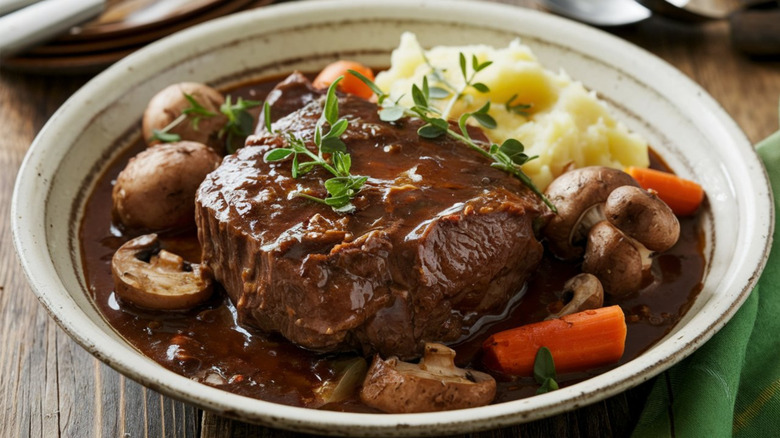Ina Garten Uses A Duo Of Boozy Ingredients To Ramp Up Her Beef Stew
Oh Burgundy, fertile land of fine wine, Charolais cattle, and Romanesque architecture. We have so much to be grateful for, and not least, beef bourguignon. Yes, the moreish beef, onion, and white mushroom stew was born in this region of Eastern France, but it wasn't until the mid-19th century that the French made the great decision to start adding wine to the dish, and only in 1961 did Julia Child's "Mastering the Art of French Cooking" catapult the recipe to global stardom. Importantly, this fueled a whole generation of home cooks realizing that if you put alcohol in pretty much any beef sauce, it makes it taste better (thank you Burgundy and thank you Julia).
American television cook and author Ina Garten is part of this club. She posted her boneless short rib stew from her cookbook "Modern Comfort Food" to Instagram, with the caption: "I usually find beef stew boring, so I made my own version and ramped up the flavor! Full-bodied red wine and cognac give the sauce an extra edge." The "Be My Guest" star, who admitted to Esquire that Grand Marnier and cognac make everything taste better, promised the dish was the "ultimate comfort food."
And fans flooded the comments to agree. "This is delicious! Made it for my dinner last night," gushed one, while another added, "Made it today — it's amazing!" followed by the winning praise: "Absolutely the best beef stew you will put on your table. Ina never disappoints."
Why does alcohol make beef stew taste so good?
You may be familiar with the art of perfectly pairing a steak with a cabernet sauvignon or malbec, and the science behind red wine and beef have perfect chemistry, but red wine also enhances the taste and texture of meat within a dish, too. This is because when you cook with alcohol, it bonds with both fat and water molecules, which makes it an effective flavor carrier. That's why a wine-based sauce can extract and infuse more complex flavors, like fat-soluble herbs and spices, than a water-based one ever could.
Alcohol also makes meat more tender by breaking down proteins in a process called denaturing. Think of it like a gentler version of how vinegar and citrus can "cook" fish in ceviche. While you probably won't get drunk off of an alcohol-infused dish, it would be a lie to say that all the alcohol magically burns off in the cooking process. Alcohol starts evaporating at 173 degrees Fahrenheit — well before water does — but depending on how much you use, how long you cook it, and whether the pot is covered, quite a bit can stick around.
This means the alcohol you choose to cook with is a big decision. Red wine adds complexity and depth to dishes like stews and sauces, with the tannins merging with other flavors over time, and the high acidity helping break down proteins in meat (warning: steer clear of jammy reds, which can become unpleasantly syrupy). On the other hand, cognac can add fruity, complex notes to a dish, with the alcohol able to cut through a meaty meal's richness, enhancing the key ingredients. So, when you're ready to follow in Ina Garten's footsteps, uncork your wine and tie up your apron, but just don't think of alcohol as an optional splash in your beef stew; it's full of flavor and is sure to elevate your dish to new heights.

